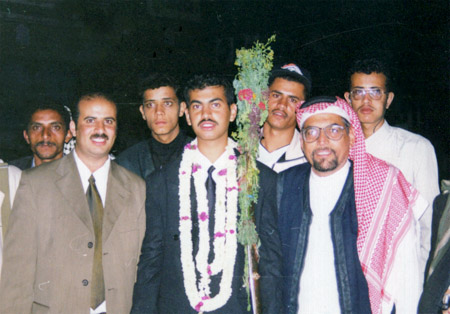
Traditional and Modern Marriage in Nadirah [Archives:2001/43/Culture]
October 22 2001

By: Saad Sharif Taher
Nadirah-Ibb
To get married is the most important event in the life of Yemenis’ because of the preparation, money and traditions it involves. As mixing between males and females is socially forbidden in the Yemeni community, choosing a wife is another task.
Half a century ago, in this town that sleeps quietly on mountains of Ibb, mothers used to suggest a girl ask her hand in a family conference. During a visit to the girl’s house, the mother expressed her desire saying, “We would like to have your daughter be a bride to my son.” If they agreed, an appointment would have made for the groom’s father and relatives.
On the very day, the bride’s father would prepare a meal and qat for the groom’s delegation. Even while chewing qat they would agree on the money paid to the bride’s father (Shartt) which was one or ten French Rials. Sometimes it was paid early, or else it was postponed until the night of the engagement.
A bag of clothes (kiswa) as well as a sheep, sugar and rice would be sent to bride’s house. The bag should be carried by a man called khadim (manservant) and his wife, the khadama (maidservant) who were devoted to such a job, as it was considered a shame for any of the groom’s relatives to carry it. Before deciding on the wedding day, they used to gaze at stars and ask a local astronomer to check whether it was ominous or good to do it on that day.
Marriage was a four-day affair which usually began on Tuesday. On Tuesday, celebrations were held in the bride’s house with dancing and firing. It was called henna night (Laylat el henna) during which the bride wore the clothes brought in the kiswa bag. That day was named according to the color of clothes she wore. Safoor (for yellow), hamoor (for red) etc. Her face was completely veiled.
On the next day, the khadama would dye the bride’s hands and feet, drawing flowers on them with black color. Sweets, gill (beans) and tea were served to the attendants amid songs and clapping. The bride would wear different clothes while her face was still completely veiled.
As for the bridegroom, men would gather near his house at night, performing the dance of Baraa among heavy firing. Sweets and tea were served. Then the Khadim dyed the groom’s hand with henna.
On the evening of the third day, the bride’s parents and relatives prepared themselves to receive the groom’s relatives and friends who would come to dance, have dinner and chew qat until dawn. It was shameful for anybody not to take part in the rejoicing. Heavy firing accompanied such activities. On the following day, after breakfast, the bride with her veiled face would be taken out by her father or anyone representing him and the Khadama. She would ride on a camel or a donkey and set out for groom’s house amidst the singing of local songs (zawamel) which praised the groom. When they arrived at the groom’s house, the bride’s father would go back home soon after advising her to obey her husband and to respect him.
The groom would receive her at the door and come with her to wedding room (without touching her or approaching her). They would sit for five or ten minutes with her face still veiled. The groom welcomed her and then went out to his guests. Sheep were slain and a big lunch was served.
After that the groom, wearing traditional clothes with the jambiyya, would go with his friends on a procession holding a sword to the shoulder. They would go to a certain place with drums beating and firing. They would dance and shoot targets to enjoy their time.
Before noon they would come back to the mosque to perform noon prayers and go back to the groom’s house where big meal would be waiting. It included porridge, salta, broth and meat. Qat was chewed until nightfall.

On Saturday morning the khadama would enter the room to take the piece of white clothing spread on the nuptial bed. As it was stained by drops of blood from virginity, she would set to bride’s parents’ house clapping and dancing among firing to declare that the bride was virgin and chaste. (The khadama was well-paid). Women gathered to witness this.
In the afternoon, the bride’s female relatives would go to congratulate her, taking with them cake and sweets which were called gulliyah, expressing their happiness that the bride was a virgin. Men would congratulate the groom, but if he failed to remove the bride’s virginity, it was considered a disgrace to him, and his friends would give him a bundle of grass to mock him.
Nowadays, it is the same as in the past, but things developed. For example, the money paid to the bride increased significantly, the wedding night became on Thursday instead of Friday, the bride’s wedding dress changed to white instead of black , games of false bullets are played, bridegrooms wear western suits on Wednesday only and, of course, the camel or the donkey has been replaced by a modern car.
——
[archive-e:43-v:2001-y:2001-d:2001-10-22-p:./2001/iss43/culture.htm]


